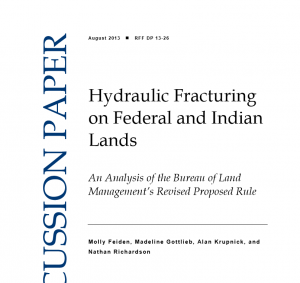Full Title: Hydraulic Fracturing on Federal and Indian Lands: An Analysis of the Bureau of Land Management's Revised Proposed Rule
Author(s): Molly Feiden, Madeline Gottlieb, Alan Krupnick & Nathan D. Richardson
Publisher(s): Resources for the Future
Publication Date: August 1, 2013
Full Text: Download Resource
Description (excerpt):
The federal government controls 700 million acres of subsurface rights (plus 56 million subsurface acres of Indian mineral estate) across 24 states, making it the largest landowner in the nation, and therefore in a position to negotiate lease terms and shape regulations of oil and gas development. The federal Bureau of Land Management’s (BLM) rules on how drilling activity can take place on federal lands essentially dictate terms, making BLM the largest “regulator” of drilling activity in the country. BLM last revised its oil and gas regulations (the Onshore Orders) in the 1980s and early 1990s, well before the recent rapid expansion of shale gas development. To date there are two rounds of proposed revisions, the first issued in 2012 and the most recent issued in May 2013, after BLM received 177,000 comments on the first round. This paper examines the 2013 proposal in several key respects, including the scope and requirements of the new proposal, the substantial changes from the 2012 proposal, and a comparison of BLM’s proposed rules with rules in states with shale gas development and significant federal land holdings, based on earlier work. We find that BLM’s proposal addresses some apparent gaps in state-level regulation and that, generally, BLM rules do not appear to impose significant requirements beyond existing state regulations, at least across the regulatory elements we analyzed and in those states with large federal land holdings.
